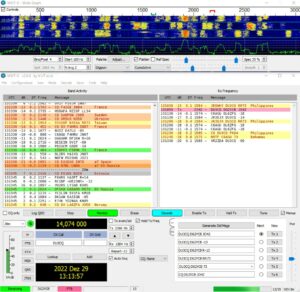WSJT-X 2.6
WSJT-X version 2.6 offers eleven different protocols or modes: FST4, Zimbabwe flag, FT8, JT4, JT9, JT65, Q65, MSK144, WSPR, FST4W a Echo. The first seven are designed to make reliable QSOs in weak signal conditions. They use almost identical message structure and coding.
JT65 was designed for EME (“moonbounce”) on VHF and higher bands and today it is mostly used for this purpose.
Q65 is particularly effective for tropospheric propagation, rain scatter, ion scatter, TEP and EME on VHF and higher bands, as well as to other types of rapidly fluctuating signals.
The JT9 was designed for shortwave with an emphasis on the lower bands. Its JT9A submode is o 1 dB more sensitive than JT65, while using less than 10 % bandwidth.
JT4 offers a wide range of pitches and has proven to be very effective for EME on microwave bands up to 24 GHz.
V “slow ones” modes use timed sequences of alternating transmit and receive. JT4, JT9 and JT65 use minute sequences, so at least a QSO takes four to six minutes – two or three broadcasts of each station – one broadcasts in odd UTC minutes and the other in even minutes. FT8 is four times faster (15-second T/R sequences) and less sensitive by a few dB. FT4 is even faster (7,5-T/R sequences) and especially suitable for contesting. FST4 is mainly intended for LF and MF bands. Both the FST4 and Q65 offer a wide range of timed sequence lengths and the Q65 a range of tonal pitches for various propagation conditions.
QSOs can be made worldwide on the KV bands with any of these modes using outputs of a few watts (or even milliwatts) and compromise antennas. QSOs are possible on VHF bands and above (using EME, reflections and other types of propagation) at signal levels o 10 to 15 dB lower than those required for CW.

WSJT-X news in version 2.6
WSJT-X 2.6 implements new features supporting the ARRL International Digital Contest and distance-based scoring. The Call 1st checkbox has been replaced with a dropdown control, which offers CQ Max Dist as an alternative. A new window called Active Stations shows a list of received ones, but raw callsigns, ranked in descending order of potential competition points. If the option CQ Max Dist, the program will select an answer to your CQ, which will bring the most competition points. By clicking on a line in the Active Stations window, you can call that station.
Decoding performance for FT8 and Q65 has been improved in various situations
Echo mode now offers a Clear Avg button and provides reliable SNR measurements even with Doppler spread. The Monitor function can be used to measure the SNR for a received unmodulated carrier, such as e.g.. a test signal transmitted by another station and reflected from the moon, and also for measuring the Sun, Moon and Earth as aids to optimize EME station performance.
New buttons in the main window allow quick changes between FT4 modes, FT8, MSK144, Q65 and JT65 and turning FT8 Hound mode on and off.
New convenience functions allow operators in Fox mode to react more quickly to specific QSO situations. The two-column table in the second tab provides an overview of the queue and callsigns with ongoing QSOs. The operator in Fox mode can change the order of the call signs in the queue, which makes it possible to respond to changes in propagation. Fox now responds automatically for the next two cycles to stations, whose report was not accepted, thereby increasing the success rate of challenging QSOs.
Working frequency table now offers save/restore option and better working with more than one frequency for combination of modes and bands. You can set preferred frequencies and the WSJT-X will select them when changing band or mode. You can mark the frequency in the table with a description, for example, the call sign of the DX expedition, and set the start and end, date and time, so the frequencies will automatically appear and disappear from the displayed options. You can load a publicly available frequency table from a file, to make such DXpedition data easily available to the program.
Optional color highlighting is available for specified DX Call and DX Grid and for messages containing RR73 or 73.
There are new options for writing to the ALL.TXT file. You can request to automatically start a new file every month or every year, and you can disable writing completely.
T/R period and submode settings are remembered by mode when switching between modes directly: for example MSK144-15, Q65-60A or FST4-120.
TX and RX audio frequencies are remembered and restored when returning from another mode, which sets the default frequencies 1500 Hz (MSK144, FST4W, Echo, WSPR, FreqCal), then switches back to FT4 mode, FT8, Q65, FST4 or JT65.
For some new radio stations, computer control is available, and for others this control is improved.
Among the new features in MAP65 (only available for Windows) includes a utility for measuring antenna routing errors and the possibility of reading the wsjtx.log file (stored by WSJT-X) to recognize duplicate EME contests. In addition, the MAP65 now sends additional information to the azel.dat file and offers optional digital scaling of the input I/Q data.
Download WSJT-X
Download is possible from https://sourceforge.net/projects/wsjt/



